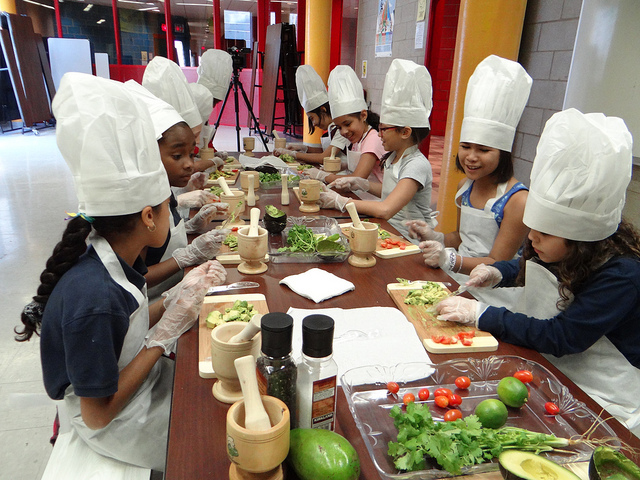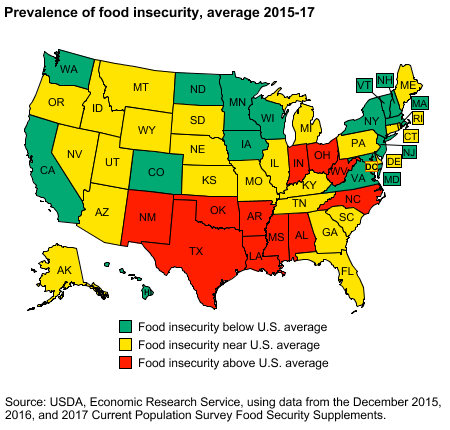United States (U.S.) households impacted by food insecurity have improved by roughly 0.5 percent from 2016 to 2017 leaving only an estimated 11.8 percent of households affected. But this percentage is still higher than the pre-recession time periods. Roughly 40 million people in the U.S. were deemed food insecure in 2017.
It is commonly thought that food insecurity deals only with having access to food. However, food insecurity is a multifaceted issue.
What is food insecurity?
The U.S. Department of Agriculture (USDA) describes food insecurity as a lack of access to healthy affordable food or resources to acquire access to food for everyone in a household due to economic or social circumstances. Another way to explain food insecurity is it takes a holistic view of food access and security issues in order to identify root causes.
I attended a seminar about food insecurity at the MBArk2Boulder conference earlier this year. Among the many causes of food insecurity, the speaker narrowed down some of the root causes to be low wages, social safety net flaws, and the broken food system. After hearing these root causes, it is clear that food insecurity not only is a multifaceted issue but it has the potential to impact everyone.
For instance, Christa Perfit, Senior Program Manager for City Harvest, suggests that “People assume that if you have a job then you must be food secure. Or that only the homeless are hungry. Many of our community members are among the working poor, who often have to choose between paying a utility bill or buying groceries for their family.”
Root causes and adverse impacts
The social safety net is provided by either the state or certain institutions to those in need of some level of assistance. Even though food insecurity effects everyone, those most impacted by food insecurity tend to be households having low annual income rates and are associated with a certain poverty level. A 2016 study found that 53% of food-insecure households live below 130% of the poverty line while 27% live above 185% of the poverty line in the U.S.
Studies have found that people with low incomes living in poverty tend to sacrifice spending money on food for expenses or immediate necessities such as healthcare, rent, transportation, and many other needs. This results in having to eat high calorie affordable unhealthy foods as well as abnormal eating habits due to fear of not knowing when the next meal will happen. This can result in health-related issues perpetuated by unhealthy eating.
It has been found that food insecurity can result in certain negative health outcomes. For instance, chronic diseases, such as obesity, heart disease, and hypertension are said to be partly the result of eating high calorie poor nutritious affordable foods.
One of the biggest needs in addressing this issue involves “a holistic exploration of the root causes that lead to food insecurity. Without a thorough understanding, we may only be patching the issue as opposed to truly moving the dial (Christa Perfit, City Harvest).”
Therefore, the real question we need to be asking here is “what aspects of food insecurity can we address?”
How to address food insecurity
It is suggested that one way to prevent chronic diseases associated with food insecurity for individuals experiencing poverty is to utilize food assistance programs. These programs include SNAP/EBT and WIC assistance. With the recent Farm Bill, funding for assistance programs benefits those who are food insecure greatly. But who knows if funding will continue for food assistance programs. This could further impact those already experiencing food insecurity.
So, who can address those who are food insecure and improve healthy diets?
I am currently researching what role organizations can take in solving healthy food diets and food system issues. Several organizations, mainly non-profits, have or are now starting to recognize they have to take a holistic view of their communities food system. By doing this, these organizations find they have the ability to address food insecurity.
For example, food banks and other non-profit organizations are starting to realize just feeding individuals is not enough to combat systemic food issues. They have started to develop programs or seeking assistance from existing programs addressing the needs of their communities targeting the root causes. Programs depend on the needs of each community but can include nutrition education, food prescription, job readiness, and much more.

Currently, I am in the middle of my thesis work but organizations that tend to be successful are those that have multiple programs focusing on food access, food prescription, food nutrition workshops, job readiness, and many others. It also takes partnerships and networks between governments, for-profits, and non-profits.
I am looking forward to seeing what results my research shows in the next coming months. In the meantime, if you want to contribute and help those experiencing food insecurity, here are a few organizations/resources you can use to volunteer your time:
- Feeding America: nationwide food bank network
- 35 Food Education Programs
- City Harvest: New York City
- Fresh Truck: Boston, MA
- Fair Food Network: Provides Solutions for Food Access
All of these resources and organizations have multiple programs or do more than just provide free food, they are addressing food system issues at their core.

